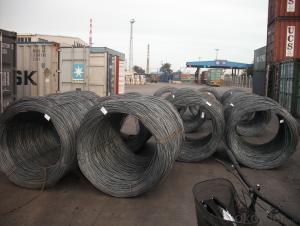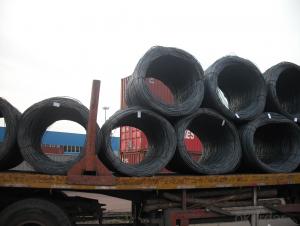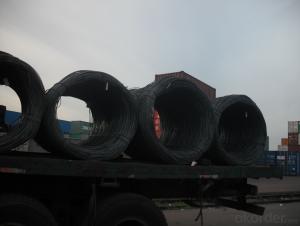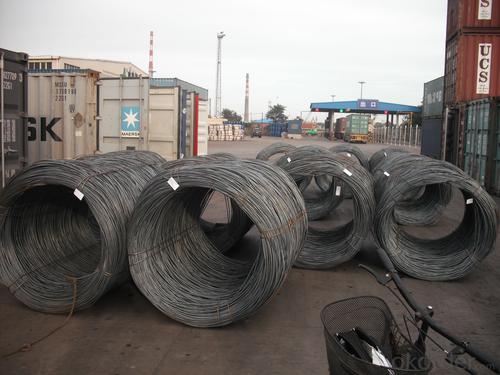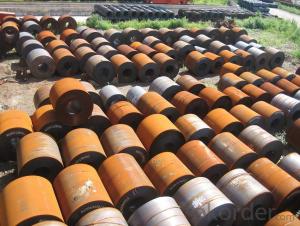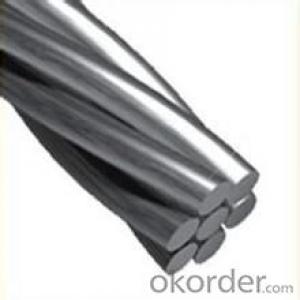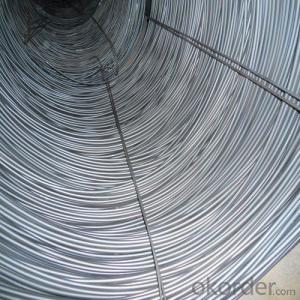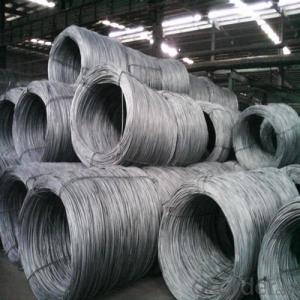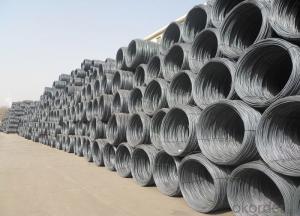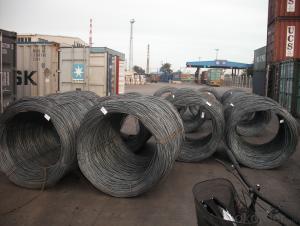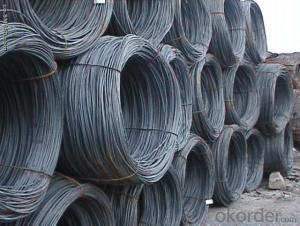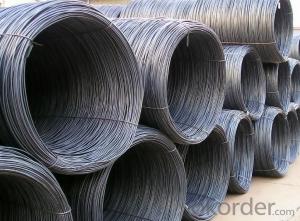Hot Rolled Carbon Steel Wire Rod Coil
- Loading Port:
- China Main Port
- Payment Terms:
- TT or LC
- Min Order Qty:
- -
- Supply Capability:
- -
OKorder Service Pledge
OKorder Financial Service
You Might Also Like
Product Description:
OKorder is offering Wire Rod at great prices with worldwide shipping. Our supplier is a world-class manufacturer of steel, with our products utilized the world over. OKorder annually supplies products to European, North American and Asian markets. We provide quotations within 24 hours of receiving an inquiry and guarantee competitive prices.
Product Applications:
After hot-rolled the products shaped into coil and delivery as finished product, including round, square, rectangular, hexagonal and so on. Since most of the products are round, it is generally called wire rod. Carbon steel wire rod is widely used in construction and manufacturing. Carbon steel wire rod is mainly used for reinforcement of reinforced concrete and welded structure or reprocessed (roberts , nail, etc.) materials, especially used to produce wire drawing, welding electrode, nails, spring, electronic, precise machinery parts and so on.
Product Advantages:
OKorder's Wire Rod are durable, strong, and resist corrosion.
Main Product Features:
· Premium quality
· Prompt delivery & seaworthy packing (30 days after receiving deposit)
· Corrosion resistance
· Can be recycled and reused
· Mill test certification
· Professional Service
· Competitive pricing
Product Specifications:
Steel Grade: Q195/235, SAE1006-1018B Standard: ASTM, GB
Diameter: 5.5mm, 6.5mm, 7mm,8mm,9mm,10mm,12mm,14mm
Type: in coil, coil weight around 2MT Alloy or Not: Alloy
Surface: round, no twisted, light and smooth Chemical Composition: (Please kindly find our chemistry of our material based on Q195、Q235A and Q235B as below for your information)
Trademark | Rank | Chemical composition (quality score) % | |||||
C | Si | Mn | S | P | |||
| ≤ |
| ≤ | ≤ | |||
Q195 |
| 0.06-0.12 | 0.30 | 0.25 | 0.050 | 0.045 | |
Q235 | A | 0.14-0.22 | 0.30 | 0.30-0.65 | 0.050 | 0.045 | |
Q235 | B | 0.12-0.20 | 0.30 | 0.30-0.70 | 0.045 | 0.045 | |
Trademark | Rank | Pulling Test | |||||
Bend PointΔs/Mpa | Tensile Strength | Elongation Ratioδ5% | |||||
Thickness (Diameter) /MM | Thickness (Diameter) /MM | ||||||
≤16 | 16-40 | ≤16 | 16-40 | ||||
≥ | ≥ | ||||||
Q195 |
| 195 | 185 | 315-390 | 33 | 32 | |
Q235 | A | 235 | 225 | 375-500 | 26 | 25 | |
Q235 | B | 235 | 225 | 375-500 | 26 | 25 | |
Payment:
-Invoicing on theoretical weight or actual weight as customer’s request.
-FOB, CFR or CIF.
-Regular terms of payment:
1, 30% payment in advance, the remaining balance (70% payment) against the copy of B/L.
2, 30% payment in advance, the remaining balance (70% L/C) against the copy of B/L.
3, Negotiable.
FAQ:
Q1: Why buy Materials & Equipment from OKorder.com?
A1: All products offered byOKorder.com are carefully selected from China's most reliable manufacturing enterprises. Through its ISO certifications, OKorder.com adheres to the highest standards and a commitment to supply chain safety and customer satisfaction.
Q2: How do we guarantee the quality of our products?
A2: We have established an advanced quality management system which conducts strict quality tests at every step, from raw materials to the final product. At the same time, we provide extensive follow-up service assurances as required.
Q3: Can stainless steel rust?
A3: Stainless does not "rust" as you think of regular steel rusting with a red oxide on the surface that flakes off. If you see red rust it is probably due to some iron particles that have contaminated the surface of the stainless steel and it is these iron particles that are rusting. Look at the source of the rusting and see if you can remove it from the surface.
Images:
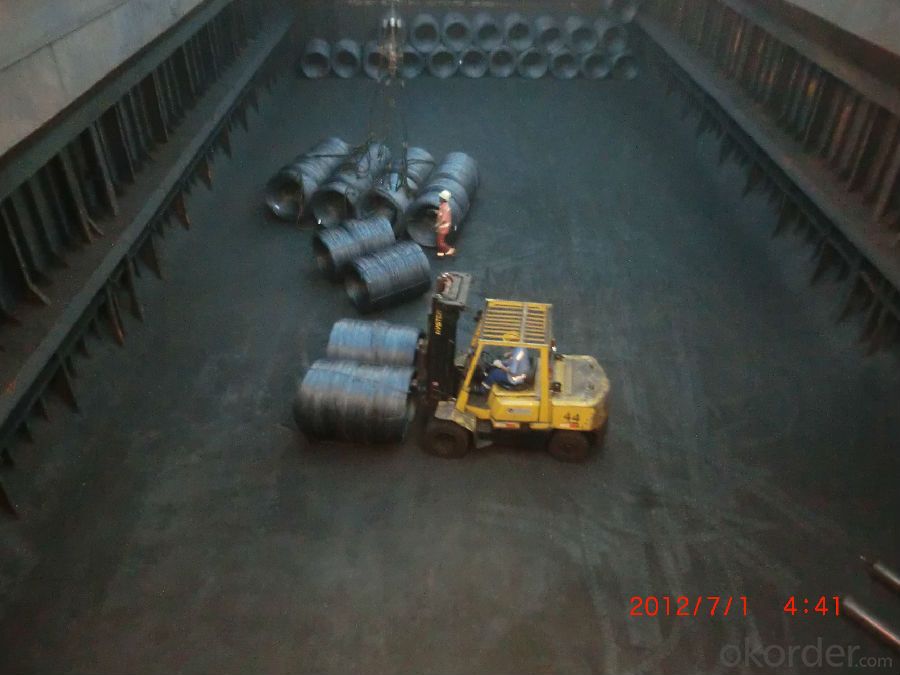
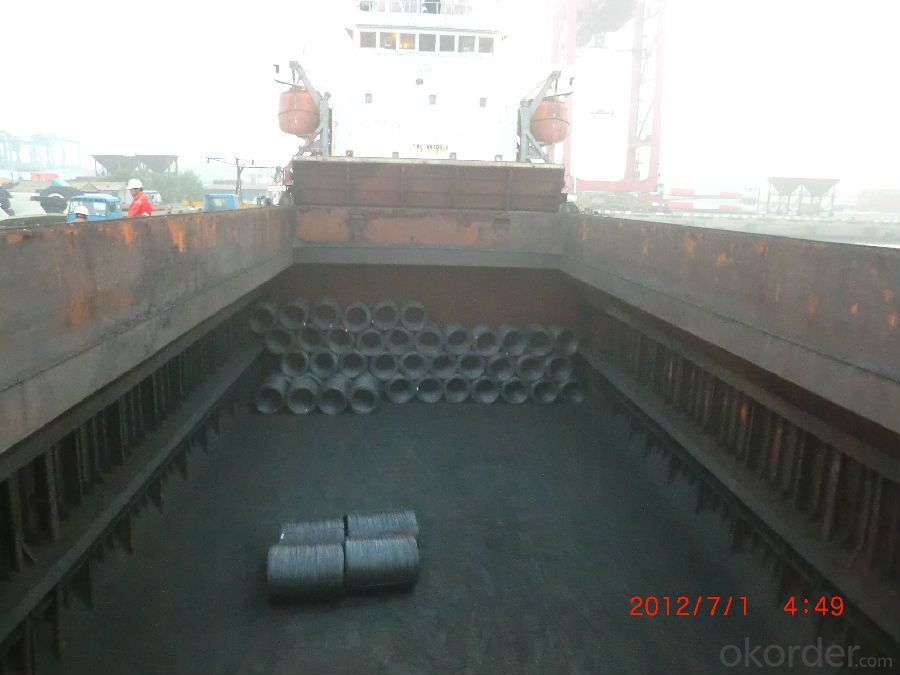
- Q: How are steel wire rods used in the manufacturing of strings for musical instruments?
- Steel wire rods are used in the manufacturing of strings for musical instruments because of their high tensile strength and durability. These rods are first drawn into thin wires, which are then wound tightly together to form the core of the string. The core is then further wrapped with materials such as nickel, silver, or bronze to enhance the tone and playability of the string. The use of steel wire rods ensures that the strings have the necessary strength and flexibility to produce clear and resonant sound when played on musical instruments.
- Q: How is steel wire rod tested for wear resistance?
- Steel wire rod is tested for wear resistance using various methods. One common approach is the pin-on-disk test, where a small pin made of the wire rod material is rubbed against a rotating disk under controlled conditions. The weight loss or wear rate of the pin is measured to determine its resistance to wear. Other tests may include abrasion testing, where the wire rod is subjected to continuous rubbing against an abrasive surface, or impact testing, where the wire rod is struck repeatedly to evaluate its durability. These tests help assess the wear resistance of steel wire rods and ensure their suitability for specific applications.
- Q: How is steel wire rod used in the manufacturing of wire rope assemblies for construction purposes?
- Steel wire rod is indispensable in the production of wire rope assemblies for construction purposes. These assemblies are widely employed in construction for a variety of uses, including lifting heavy loads, securing structures, and providing structural support. Steel wire rod acts as the raw material for fabricating the inner and outer strands of a wire rope assembly. These strands are created by intertwining multiple individual wires, resulting in a robust and long-lasting rope. Typically, the wire rod utilized in this process consists of high-quality carbon steel, which imparts the necessary strength and resilience required for construction applications. The manufacturing process commences with the cleaning and lubrication of the steel wire rod to decrease friction during the twisting procedure. Subsequently, the wire rod is drawn through a sequence of dies to decrease its diameter and increase its length. This drawing process aids in aligning the steel's grain structure, thereby improving its strength and flexibility. Once the wire rod has been drawn, it is inserted into a stranding machine where numerous wires are twisted together to form individual strands. These strands are then combined in a specific pattern to construct the wire rope assembly, with the inner strands providing strength and the outer strands offering protection. The wire rope assembly is subsequently subjected to various quality control measures to ensure compliance with the required specifications for construction purposes. These measures may encompass testing for strength, flexibility, and resistance to corrosion. Upon approval, the wire rope assembly is deemed fit for use in construction projects. In the construction industry, wire rope assemblies crafted from steel wire rod find wide-ranging applications. They are frequently utilized in cranes and hoists for lifting heavy loads, offering a secure and dependable lifting solution. Wire rope assemblies are also employed in the construction of suspension bridges, where they provide support and stability. Furthermore, these assemblies are employed for securing structures, such as in the installation of safety barriers or anchoring systems. Overall, steel wire rod plays a pivotal role in the production of wire rope assemblies for construction purposes. Its strength, durability, and versatility make it an ideal material for diverse construction applications, ensuring the safety and dependability of structures and equipment.
- Q: What are the common production processes for xenon-coated steel wire rod?
- The common production processes for xenon-coated steel wire rod typically involve cleaning and pre-treating the steel wire rod, followed by applying a xenon coating using various methods such as physical vapor deposition or chemical vapor deposition. The coated wire rod is then subjected to curing or annealing processes to enhance the adhesion and durability of the xenon coating. Finally, the wire rod is further processed into desired shapes or sizes for specific applications.
- Q: How is steel wire rod used in the manufacturing of wire forms for HVAC systems?
- Steel wire rod is an essential component in the manufacturing of wire forms for HVAC systems. These wire forms are key elements that provide structural support and stability to the HVAC system. Firstly, steel wire rod is used to produce the actual wire used in wire forms. The rod is typically made of high-quality steel, which ensures the wire's strength and durability. The rod is then processed through various manufacturing techniques such as drawing, annealing, and coating to create the desired wire diameter and properties. Once the wire is formed, it can be utilized in different ways within HVAC systems. For instance, it can be used to create wire forms that are used as support structures for air ducts. These wire forms provide a sturdy framework that maintains the shape and integrity of the ductwork. Additionally, steel wire rod can be used to manufacture wire forms that act as reinforcement for HVAC components. For example, it can be used to create wire grids that are placed behind air filters to enhance their structural stability and prevent them from collapsing under pressure. Wire forms made from steel wire rod can also be used as fasteners or connectors within HVAC systems. They can be shaped into hooks, clips, or springs that hold various components together, ensuring a secure and reliable connection. The use of steel wire rod in the manufacturing of wire forms for HVAC systems provides several benefits. Steel is known for its strength and durability, making it an ideal material for withstanding the harsh conditions often encountered in HVAC applications. It also has excellent corrosion resistance, ensuring the longevity of the wire forms in different environments. In conclusion, steel wire rod is an indispensable material in the manufacturing of wire forms for HVAC systems. Its strength, durability, and versatility make it a suitable choice for creating wire forms that provide structural support, reinforcement, and fastening mechanisms within HVAC systems.
- Q: How is steel wire rod used in the production of fasteners?
- Steel wire rod is commonly used in the production of fasteners as it serves as the primary material for creating various types of screws, bolts, and nails. The wire rod is first heated and then drawn through a series of dies to achieve the desired shape and dimensions. This process enhances the strength and durability of the fasteners, making them suitable for a wide range of industrial and construction applications.
- Q: What are the main factors influencing the choice of steel wire rod order confirmation process?
- The selection of the order confirmation process for steel wire rod is influenced by various factors related to the business and industry. However, there are certain common factors that typically affect this decision: 1. Customer preferences: The specific requirements and preferences of customers are crucial in determining the order confirmation process. Some customers may prefer a streamlined and automated process, while others may require a personalized and manual approach. 2. Complexity of orders: The complexity of the steel wire rod order can also impact the choice of confirmation process. If the order involves multiple specifications, customizations, or special requirements, a more detailed and thorough confirmation process may be necessary for accuracy. 3. Order volume: The volume of orders received by the business can also influence the choice of confirmation process. For smaller order volumes, a simpler and less time-consuming process may suffice. Conversely, larger order volumes may require a more efficient and automated confirmation process to handle the increased workload. 4. Time sensitivity: The urgency or time sensitivity of the order is another factor to consider. If the order needs quick confirmation to meet tight deadlines, a streamlined and expedited confirmation process may be necessary. 5. Internal capabilities: The internal capabilities and resources of the business also play a role in determining the order confirmation process. If the business has advanced technology and systems in place, it may be able to implement a more automated and efficient confirmation process. Conversely, if resources are limited, a more manual and time-consuming process may be the only viable option. 6. Industry standards and regulations: Certain industries have specific standards and regulations that dictate the order confirmation process. Compliance with these standards is crucial, and the choice of confirmation process may need to align with industry requirements. 7. Risk management: The level of risk associated with the order can influence the choice of confirmation process. If there are potential risks or uncertainties involved, a more comprehensive and detailed confirmation process may be necessary to minimize errors or discrepancies. In conclusion, a careful evaluation of these factors is necessary to ensure an efficient, accurate, and customer-centric order processing in the steel wire rod industry.
- Q: How is the chemical composition of steel wire rod analyzed?
- Various techniques and methods are typically used to analyze the chemical composition of steel wire rod. One commonly employed method is spectroscopy, which utilizes instruments like atomic absorption spectroscopy (AAS) or inductively coupled plasma spectroscopy (ICP) to accurately determine the presence and concentration of different elements in the steel wire rod. Another frequently used technique is X-ray fluorescence (XRF), which involves bombarding the sample with X-rays and measuring the energy emitted by the elements present in the steel wire rod. This method provides a fast and non-destructive analysis of the chemical composition. In addition to spectroscopy and XRF, other methods such as optical emission spectroscopy (OES) and mass spectrometry can also be utilized for analyzing the chemical composition of steel wire rod. These techniques involve vaporizing and ionizing the sample, followed by measuring the resulting ions or emitted photons. It is important to note that these techniques necessitate the preparation of the steel wire rod as a sample, often in the form of a solid or liquid. The sample is typically dissolved, digested, or mixed with appropriate reagents to extract the elements of interest before analysis. Overall, analyzing the chemical composition of steel wire rod is a critical step in quality control and ensuring that the material meets the required specifications for its intended use.
- Q: What are the different surface finishes available for steel wire rods?
- There are several surface finishes available for steel wire rods, including hot-dip galvanized, electro-galvanized, phosphatized, and uncoated. Each finish offers unique properties and benefits depending on the intended application and environmental conditions.
- Q: What are the factors that affect the strength of steel wire rod?
- The factors that affect the strength of steel wire rod include the composition of the steel, the manufacturing process used, the heat treatment applied, the presence of impurities or defects, and the level of strain or stress the wire rod is subjected to. Additionally, factors such as the diameter, length, and surface condition of the wire rod can also influence its strength.
Send your message to us
Hot Rolled Carbon Steel Wire Rod Coil
- Loading Port:
- China Main Port
- Payment Terms:
- TT or LC
- Min Order Qty:
- -
- Supply Capability:
- -
OKorder Service Pledge
OKorder Financial Service
Similar products
Hot products
Hot Searches
Related keywords
